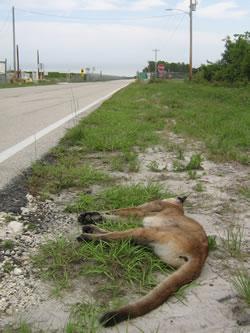The endangered Florida panther population has taken a big hit. In 2014, 30 of these elusive felines, listed as an endangered species for more than 40 years, have died, the majority of which met their fates on highways in three southwest Florida counties: Collier, Lee and Hendry.
Four of the deaths occurred near the Big Cypress National Preserve, and more than a third of the deaths were females of kitten-bearing age. The 30 dead cats represents a 50 percent increase from 2013, according to Public Employees for Environmental Responsibility, and exceeds the previous record of 27 deaths counted in 2012.
While the panther once roamed much of the eastern United States, it is now confined to just a small area in southwest Florida, 5 percent of its original range. This year's number of fatalities may represent up to a quarter of the entire panther population, though exact counts are difficult to obtain because the use of radio tracking has declined. Only seven of the dead panthers this past year were wearing radio collars.
According to PEER Executive Director Jeff Ruch, "The management of the Florida panther is biology by body count.”
The U.S. Fish and Wildlife Service has recorded 32 kittens born this year, but their survival rate is low. The population is in decline and long-term recovery seems bleak, according to PEER. The reduction in genetic diversity has also affected these cats.
PEER points to Florida's new, sprawling development in panther country, and an increase in off-road vehicle traffic, specifically in the Big Cypress National Preserve Addition Lands, as contributors to the high fatality count. And, the U.S. Fish and Wildlife Service has not designated critical habitat for the animal. From 1984 to 2009, the agency approved 127 developments that could affect habitat, according to PEER.
"In south Florida, the panther literally is a speed bump to sprawling development,” Ruch said. “Many believe we have already reached the tipping point where a viable population of Florida panther can no longer exist in the wild and the future of this alpha-predator is as a zoo species.”


 Support Essential Coverage of Essential Places
Support Essential Coverage of Essential Places







Comments
Sometimes Rick B. it takes a screed rather than sniping soundbites to help those quite ignorant to a complicated not too well uhnderstood topic like panthers and the fraud all around them.
It really isn't their fault but is the fault of the folks in charge.
OK, Frank. Whatever you say.
How about the python, Frank? Eats a lot of small mammals, was not government introduced, what about the pythons?
Okay, I will bite.
Kind of true. The Piper Cats were a mix of Central American Cats and Florida Panthers. The Zoo bred them because they were having problems with breeding pure Florida Panthers - many were sterile. NPS released a few (seven) into the Everglades.
Not True. In fact, Roelke discovered there were two distinct groups of Florida Panthers - the original ones (Big Cypress) and the ones with introduced South American DNA (Everglades). However, the Everglades population died out by 1991 - most likely due to mercury poisoning.
Yada, yada, yada...
From my previous 5:58 pm post "...along with all the other uncontrolled predators..."
All predators should be controlled along with panthers - plain and simple.
Read the book (although it sounds like you might have) - my recollection is that they (NPS) never figured the imports could cross the river of grass but they did during a very dry year into Big Cypress.
Truth be known NPS had it right - just go buy a few panthers whenever you run low and kick them out of the back of a truck. Would have saved the taxpayers from having to employ all the unemployables they have been supporting for decades. A third grader could have figured that out but the powers that be had fancier less smart plans.
Now we have a Frankenstein cat that is still defective and always be was created by man not nature.
Again - way to go .gov guys (oh and gals).
So, Frank - taking a guess here - what year was it that you applied to work for the government and got turned down?
Come on Rick B., it's time to reel in the trolling line.